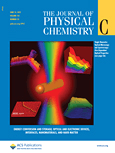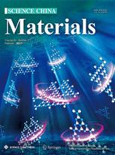
Materials Chemistry Frontiers
Scope & Guideline
Pioneering Research at the Intersection of Chemistry and Materials
Introduction
Aims and Scopes
- Material Synthesis and Characterization:
The journal emphasizes the synthesis of novel materials, including organic-inorganic hybrids, metal-organic frameworks (MOFs), and nanostructures, as well as their detailed characterization to understand their properties and functionalities. - Energy Storage and Conversion:
Research in this journal often explores advanced materials for batteries, supercapacitors, and fuel cells, aiming at improving efficiency, stability, and sustainability of energy storage systems. - Photonic and Optoelectronic Materials:
There is a strong focus on materials for photonic applications, including light-emitting diodes (LEDs), solar cells, and photodetectors, emphasizing the design of materials with tailored optical properties. - Biomaterials and Environmental Applications:
The journal includes studies on biomaterials for medical applications and environmentally friendly materials for waste remediation and energy harvesting, highlighting the role of materials in sustainability. - Catalysis and Electrocatalysis:
A significant portion of the research is dedicated to the development of catalysts for various chemical reactions, particularly electrocatalysts for energy conversion processes like hydrogen evolution. - Nanomaterials and Nanotechnology:
The journal features research on nanomaterials, exploring their unique properties and applications in various domains, including drug delivery, sensing, and catalysis.
Trending and Emerging
- Hybrid and Composite Materials:
There is a growing interest in hybrid materials that combine organic and inorganic components, as well as composites that enhance performance in applications such as energy storage and sensing. - Sustainable and Green Materials:
Research focusing on sustainable materials, including bio-derived and recyclable substances, has gained momentum, reflecting a global push towards environmentally friendly practices. - Advanced Energy Storage Solutions:
Emerging themes in the development of next-generation batteries, such as sodium-ion and solid-state batteries, are becoming prominent, driven by the need for improved energy storage technologies. - Smart and Responsive Materials:
Materials that can respond to environmental stimuli (temperature, light, pH) are increasingly significant, particularly in applications for drug delivery and environmental sensing. - Two-Dimensional Materials:
Research into two-dimensional materials, such as MXenes and graphene derivatives, is on the rise due to their unique properties and potential applications in electronics, catalysis, and energy storage. - Photothermal and Photodynamic Therapies:
There is an increasing focus on materials for photothermal and photodynamic therapies in medical applications, particularly for cancer treatment, leveraging the unique optical properties of new materials.
Declining or Waning
- Conventional Organic Photovoltaics:
Research on traditional organic photovoltaics has waned as the field pivots towards more efficient and stable materials, such as perovskites and non-fullerene acceptors, which offer better performance metrics. - Traditional Inorganic Materials:
There appears to be a decreasing emphasis on purely inorganic materials without hybridization or nanostructuring, as researchers increasingly explore composite and multifunctional materials. - Static Materials for Low-Tech Applications:
Research focusing on static materials with limited functionalities has declined as the demand for smart, responsive, and multifunctional materials has increased, driven by advances in technology. - Basic Theoretical Studies:
The journal has shifted focus away from purely theoretical studies towards more application-driven research, which integrates theory with experimental validation. - Single-Function Materials:
Research on materials designed for single functions, such as just energy storage or just catalysis, is being replaced by studies on multifunctional materials that can perform multiple tasks simultaneously.
Similar Journals

ACS Materials Au
Advancing Innovations in Materials EngineeringACS Materials Au, published by the American Chemical Society, is a premier open-access journal that has been at the forefront of materials science since its inception in 2021. With an ISSN of 2694-2461, this journal encompasses an expansive range of topics including biomaterials, electronic, optical and magnetic materials, materials chemistry, and polymers and plastics, consistently achieving Q1 rankings in these categories for 2023. The journal is based in the United States and operates from the AMS's headquarters in Washington, DC, offering significant visibility and a robust platform for researchers. The journal's commitment to open access ensures wide dissemination of groundbreaking research, enabling a diverse audience—including researchers, professionals, and students—to engage with the latest advancements in materials science. With an encouraging impact factor and a focus on novel materials and innovative applications, ACS Materials Au stands as a vital resource for anyone devoted to understanding and advancing the frontiers of materials engineering and science.

SusMat
Discovering Tomorrow's Sustainable Technologies TodaySusMat is a pioneering open access journal published by WILEY, with an ISSN of 2766-8479 and E-ISSN of 2692-4552, dedicated to advancing knowledge in the field of sustainable materials and technologies. Launched in 2021, SusMat aims to provide a vibrant platform for researchers, professionals, and students from interdisciplinary backgrounds to explore and disseminate innovative materials and strategies that promote sustainability. With an emphasis on high-quality, peer-reviewed research, this journal contributes to the growing body of literature essential for addressing contemporary environmental challenges. Furthermore, the open access format enhances accessibility and dissemination of knowledge, encouraging broader engagement and collaboration within the scientific community. Discover the future of sustainable materials at SusMat, where impactful research meets global sustainability goals.

Journal of Physical Chemistry C
Unraveling the mysteries of nanoscience and beyond.The Journal of Physical Chemistry C, published by the American Chemical Society, stands as a pivotal resource in the realm of materials science and physical chemistry. With an impact factor reflecting its esteemed reputation, this journal showcases high-quality research spanning topics such as electronic, optical, and magnetic materials, as well as nanoscience and nanotechnology. Hailing from the United States, it operates without an open access model, yet its contributions are critical for advancing our understanding of surfaces, coatings, and films. Notably, the journal is classified in Quartile 1 (Q1) for several categories, underscoring its prominence in Physical and Theoretical Chemistry and related fields. Researchers, professionals, and students alike will find value in the comprehensive discussions and innovative research trends presented. The scholarly articles published from 2007 to 2024 not only drive forward scientific inquiry but also inform practical applications in various industries, making this journal an essential tool for anyone committed to excellence in the sciences.

Frontiers in Materials
Connecting Researchers to Shape Tomorrow's Materials.Frontiers in Materials, an esteemed journal published by FRONTIERS MEDIA SA, is a leading platform in the field of Materials Science, with a notable impact factor placing it in the Q2 category of its discipline as of 2023. Since its establishment as an Open Access journal in 2014, it has fostered considerable academic exchange, allowing researchers from around the globe to share their innovative findings and insights. Based in Lausanne, Switzerland, this journal not only emphasizes high-quality peer-reviewed articles but also prioritizes rapid dissemination of research, as evidenced by its commendable Scopus ranking of #62 out of 196 in Materials Science (miscellaneous). By consistently striving to bridge the gap between academia and practical applications, Frontiers in Materials serves as an invaluable resource for researchers, professionals, and students seeking to delve into cutting-edge advancements and transformative applications in materials science.

Nano Express
Catalyzing global dialogue in nanotechnology.Nano Express is an esteemed open-access journal published by IOP Publishing Ltd, dedicated to advancing research in the fields of nanotechnology and materials science. Since its launch in 2020, the journal has swiftly established itself as a vital resource for researchers and professionals, garnering significant recognition in various domains, including biomaterials, electronic, optical and magnetic materials, and polymers and plastics. With a commendable categorization in Scopus quartiles, it ranks in Q2 for Electronic, Optical and Magnetic Materials, and maintains a top percentile in several others, exemplifying its commitment to high-quality research dissemination. Located in the United Kingdom, this journal fosters a global dialogue among experts and newcomers alike, facilitating open access to innovative research that drives the future of nanotechnology. By offering a platform for groundbreaking studies and reviews, Nano Express aims to bridge the gap between theoretical understanding and practical application, championing the development of next-generation materials that have the potential to transform various industries.

Journal of Materials Chemistry C
Advancing the Frontiers of Material InnovationJournal of Materials Chemistry C, published by the renowned Royal Society of Chemistry, is a leading academic journal focusing on innovative research in the field of materials chemistry. With an impressive impact factor, this journal has solidified its status as a top-tier publication within its field, ranking in the Q1 category for both Chemistry (miscellaneous) and Materials Chemistry as of 2023. Positioned at the forefront of -materials science, it serves as a vital platform for researchers, professionals, and students to disseminate findings that highlight the synthesis, characterization, and application of advanced materials. The journal's open access model allows for broader readership and engagement, ensuring that groundbreaking research is accessible to a global audience. As a result, the Journal of Materials Chemistry C plays a crucial role in advancing the understanding and technology of materials, fostering collaboration and innovation within this dynamic scientific community.

Journal of Ovonic Research
Illuminating the Future of Electronic and Optical Materials.Journal of Ovonic Research is a distinguished publication dedicated to advancing the fields of electronic, optical, and magnetic materials. Published by VIRTUAL CO PHYSICS SRL, this journal offers a platform for researchers to share innovative findings and developments that push the boundaries of technology and materials science. With an ISSN of 1842-2403 and an E-ISSN of 1584-9953, it provides an important service to the academic community, particularly within Romania and beyond. Despite its recent inception in 2011, the journal has gained traction in the academic landscape, reflecting a Q4 quartile ranking in crucial categories such as Electronic, Optical and Magnetic Materials, as well as in Physics and Astronomy. The Scopus rankings further underscore its positioning, ranking within the 25th to 37th percentile across various disciplines, making it a valuable resource for professionals and students alike. Although the journal currently operates on a non-open access basis, it remains committed to exploring the latest advancements in materials science, encouraging interdisciplinary collaboration and fostering a deeper understanding of surface, coating, and film technologies. As the field evolves, Journal of Ovonic Research stands as a beacon for scholarly communication, bridging the gap between research and practical application.

Science China-Chemistry
Empowering Chemists with Cutting-Edge DiscoveriesScience China-Chemistry, published by SCIENCE PRESS, stands as a leading journal in the field of chemistry, specifically recognized for its contributions in miscellaneous chemistry domains. With an impressive Q1 categorization in the 2023 quartiles and ranking at #35/408 in general chemistry by Scopus, this journal places itself within the top 91st percentile, showcasing its significant impact in the discipline. The journal, based in Beijing, China, provides a platform for innovative research, reviews, and insights that cater to an international audience of researchers, professionals, and students dedicated to advancing chemical science. As an open-access journal, it ensures widespread dissemination of knowledge, making cutting-edge research accessible to all. With converged years from 2010 to 2024, the journal continues to be a vital resource for those engaged with the latest developments in chemistry.

Science China-Materials
Exploring the Future of Materials Engineering.Science China-Materials is an esteemed peer-reviewed journal dedicated to advancing the field of materials science, published by SCIENCE PRESS. With a strong focus on innovative research and applications, this journal provides an essential platform for disseminating groundbreaking findings in materials development, characterization, and engineering. Since its inception, Science China-Materials has achieved an impressive Q1 ranking in the Materials Science (miscellaneous) category, reflecting its commitment to quality and the impact of its publications, as indicated by its 86th percentile ranking in Scopus. The journal is set to converge its contributions from 2016 to 2024, making it a vital resource for researchers and professionals interested in the latest advancements and trends in materials science. As an open access publication, it ensures that knowledge is freely available to a global audience, promoting collaboration and innovation across disciplines. The journal is headquartered in Beijing, China, and continues to attract high-quality submissions from leading experts in the field.

CHINESE JOURNAL OF STRUCTURAL CHEMISTRY
Advancing the Frontiers of Structural ChemistryThe CHINESE JOURNAL OF STRUCTURAL CHEMISTRY, published by Elsevier, stands as a vital resource in the field of structural chemistry, notably contributing to the advancement of knowledge since its inception in 1996. With its ISSN 0254-5861 and E-ISSN 0254-5861, the journal has established a firm reputation, garnering a Q2 ranking in the 2023 Chemistry (miscellaneous) category, which highlights its influence in the academic community (rank #155/408, 62nd percentile in Scopus). This journal serves as an invaluable platform for researchers and professionals by disseminating high-quality research findings, theoretical studies, and applied methodologies that address both fundamental aspects and emerging trends in structural chemistry. With contributions from distinguished scholars, it aims to foster innovation and collaboration, while providing a space for novel discoveries in the field. Although it does not currently offer Open Access, its robust content continues to attract a diverse readership eager to engage with cutting-edge scientific developments.